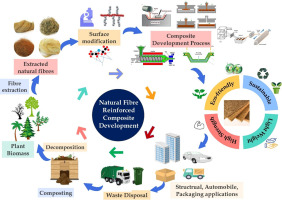Natural fiber-based biocomposites have emerged as a compelling alternative to synthetic materials, which are often non-renewable, non-biodegradable and produced through environmentally harmful processes [1]. The growing focus on sustainability and environmental protection has fueled demand and interest in bio-composites in recent years. An important trend in this area is the use of natural fibers as reinforcement, which represents an environmentally friendly option compared to traditional synthetic fibers and petrochemical polymers [2,3]. This change is being driven not only by environmental concerns but also by technological advances that are improving the performance and feasibility of biocomposites for various applications.
Biocomposites represent a unique class of materials created by combining a polymer matrix with natural fiber reinforcements. These reinforcements can be broadly classified into two types: non-wood fibers and wood fibers [4]. Most natural fibers are characterized by their long-chain structure and high cellulose content, which gives them excellent tensile strength and a high degree of crystallinity, making them suitable for various applications [5]. The growing global demand for natural fibers is triggering a shift towards sustainable and environmentally friendly composite materials. Natural fibers, known for their biodegradability and versatile properties, have gained importance in international markets, leading to increased export of natural fiber-based products, including biocomposites [6]. However, one of the biggest challenges with natural fibers is their hydrophilic nature, which is due to the presence of hydroxyl groups (OH), which easily absorb moisture and potentially affect the material's durability and performance in certain environments [7]. In addition, moisture absorption leads to swelling of the reinforcing fibers, resulting in the formation of voids at the interface of the composite. This in turn reduces the mechanical properties and overall dimensional stability of the composite materials [8,9]. Addressing this limitation through surface modification or treatment methods is crucial for optimizing the properties of biocomposites for various industrial applications. Recent studies have shown that the incorporation of treated natural fibers into the polymer matrices not only increases tensile strength but also improves physical and thermal stability, especially when combined with protective treatments and surface modifications. These treatments reduce water absorption and void content and improve interfacial compatibility, which are common drawbacks in composites manufactured by solution casting and wet hand application processes, thereby improving performance and durability [10]. For example, sisal fiber composites with epoxy coating showed excellent mechanical and water-resistant properties, while soy protein-sisal biocomposites with chitosan and phytagel as reinforcing materials showed remarkable improvements in strength and thermal stability [11,12]. Figure 1 provides an overview of the development process of natural fiber-reinforced biocomposites.
Composites, especially biocomposites, are constantly gaining importance in various industries including transportation, construction, packaging and consumer products, etc. due to their environmental sustainability and versatility. [13]. There are a number of compelling reasons for the introduction of biocomposites that underline their advantages. First and foremost, these materials help maintain ecological balance by minimizing environmental degradation. They also play a crucial role in reducing dependence on non-renewable petroleum resources, which are finite and subject to depletion. In addition, biocomposites offer a way to recycle agricultural residues, convert waste into valuable materials and promote resource efficiency [14]. These positive attributes are consistent with global efforts to support human well-being and also increase economic prosperity through sustainable practices. In addition, biocomposites have an excellent strength-to-weight ratio, making them ideal for lightweight and durable materials applications. The excellent corrosion resistance of biocomposites expands their potential for use under harsh environmental conditions and strengthens their status as a sustainable alternative in modern industries [15,16].
Despite the significant growth in the development of sustainable natural fiber reinforced composites, there is still a significant research gap in fully understanding the long-term performance of biocomposites, hybrid composites, manufacturing processes and methods to improve the performance properties of biocomposite materials, various surface modification techniques, etc. While advances in fiber modification and While matrix compatibility has led to improved mechanical properties and moisture resistance, the effects of these innovations in real environmental conditions are still poorly understood. Furthermore, the integration of these biodegradable materials into large-scale structural systems and high-performance eco-friendly packaging lacks comprehensive life cycle assessments and standardized testing protocols. This gap hinders the wider adoption of sustainable composites in commercial and industrial applications, particularly in the automotive sector, aerospace and marine applications, furniture, textile and structural applications, highlighting the need for interdisciplinary studies.
This review reviews various natural fibers and their compatibility with various polymer matrices, as well as surface modification techniques that enhance fiber-matrix interactions to improve mechanical strength, fiber-matrix bonding, and durability of composites. In addition, manufacturing processes and performance enhancement methods in composite materials development are explored, with a focus on applications in food packaging, industrial, marine/aerospace, and high performance structural components, etc. Additionally, the study highlights the growing interest in the field of hybrid composites that integrate multiple reinforcements for superior properties. In addition, a detailed life cycle assessment of biocomposites is also recorded, highlighting their environmental benefits, including reduced carbon emissions and biodegradability.
